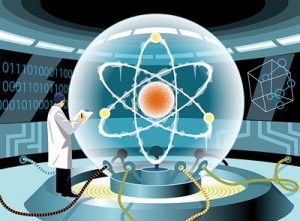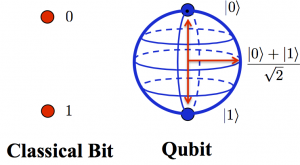 The qubit is the unit of quantum information, a superposition of states, used to realize quantum computers. Why we do not yet have quantum computers? Where are the q(uantum)-phone, quantum games and virtual realities?
The qubit is the unit of quantum information, a superposition of states, used to realize quantum computers. Why we do not yet have quantum computers? Where are the q(uantum)-phone, quantum games and virtual realities?
Let’s start our journey towards quantum computers from quantum mechanics, the theory which describes the microscopic world, discovered about 100 years ago, and which is one of the main pillars of Modern Physics, together with the relativity theory. Quantum mechanics is “at work” in all our modern technologies, since transistors rely on quantum features of atoms.
In the beginning of the 20th century, when atoms were understood to be made of a small and dense central nucleus, orbited by electrons, this picture was inconsistent with the laws of nature (what we presently call classical mechanics) known by that time. The negatively charged electrons orbiting the central positively charged nucleus should have emitted radiation, losing their energy in an extremely short time interval and collapse on the nucleus. But atoms do exist and they are stable!
The atomic physics posed other puzzling questions, related to atomic spectra. All these mysteries were solved by Niels Bohr who set the basis of quantum mechanics, by postulating that electrons in atoms are in stable orbitals, where they do not emit energy. Together with the explanation of other phenomena, such as the photoelectric effect by Einstein and the black body radiation by Planck, the explanation of the stability of atoms by Bohr represented the early stage of quantum theory, which even today triggers debates and discussions, but also set the basis for new technologies, such as quantum computers.
Another important contribution was given by Erwin Schrödinger, an Austrian scientist famous for the equation he published in 1926, for which he received the Nobel Prize in Physics in 1933. The Schrödinger equation is fundamental in quantum mechanics and it describes the quantum systems by using the so-called “wave function”, a complex function of space-time coordinates of the system, and is used to make computations. The Schrödinger equation does not tell us which will be the specific result of an experiment, it only gives the probabilities of the possible measurements. Quantum mechanics is intrinsically a probabilistic theory. In classical mechanics by knowing the initial state we can calculate with precision which will be the outcome on an observation, but in quantum physics we can only calculate probabilities and there is no way to know with certainty which will be the final result (when more than one outcomes are possible).Quantum world is so different than our daily experience!
Let’ s proceed with an example: the decay of radioactive nuclei. Quantum mechanics allows us to calculate how many nuclei will decay in a certain time interval, but it dos not tell us which nucleus will decay and which not. If we take for example one specific nucleus, we can say that after a period of time there is 50% probability it decays and 50% it does not decay. No way to know more! The wave function of the system is in a superposition of states: decayed and not-decayed nuclei. When more outcomes are possible the wave function is a superposition of all of them.
However, when we realize a measurement we do not see a superposition of states. The nucleus in our case is either decayed or it is not. We measure only one of the possible final states. So, after the measurement the wave function of the system collapsed in one of the possible states. The collapse of the wave function in quantum mechanics, introduced as a postulate, is related to the so-called “measurement problem” and to the famous “Schrödinger’s cat” paradox, which triggered and continues to do so many debates and discussions, not only in physics but also in the philosophy of science.
A quantum computer uses the superposition of states to replace the “bit” of the present computers, which can be either in “0” state or in “1”, with the qubit, which can be simultaneously in both states, 0 and 1. This would make in principle quantum computers faster than those we have today. But, in order to make quantum computers working, the quantum superposition of states needs to be maintained (as long as possible). If the quantum system interacts with other systems, for example with the environment (gas molecules) the decoherence occurs and the quantum computer does not work anymore; the qubit disappears! Maintaining the quantum system isolated is however a very difficult task: even an air molecule may break the genuine quantum behavior!
In spite of all difficulties many teams all around the world use various technologies, as spin states, superconductors, optical devices, to realize prototypes of quantum computers with the hope to have in the next 10 – 20 years working devices.
There is yet another problem, a conceptual one. If for microscopic systems the superposition of states is demonstrated, it is not yet certain that quantum mechanics describes also macroscopic objects. There are researchers who proposed theories and/or models “beyond the actual quantum mechanics” which would be only a limiting case of a theory yet to be discovered (as Galileo/Newton classical mechanics is a limiting case of Einstein’s gravity theory). Myself I am leading two projects, one financed by the Foundational Questions Institute (FQXi) (“Events” as we see them: experimental test of the collapse models as a solution of the measurement-problem) and the other one by Enrico Fermi Historical Museum of Physics and Study and Research Centre (Open problems in Quantum Mechanics), in the framework of which we search for experimental signatures of theories beyond actual quantum mechanics (collapse models).
Many other studies, theoretical and experimental, are inquiring the Quantum Theory, both to better understand it and also towards the developments of quantum technologies, such as quantum computer. In a recent article published in the journal Physical Review Letters, Martí Perarnau-Llobet and collaborators showed, for example, that quantum systems “work” best when left unobserved.
Quantum computers pose incredible challenges, but, as David Deutsch (pioneer of quantum computers) said “To me quantum computation is a new and deeper and better way to understand the laws of physics, and hence understanding physical reality as a whole.” (Catalina Curceanu)
 INFN-LNF Laboratori Nazionali di Frascati
INFN-LNF Laboratori Nazionali di Frascati
